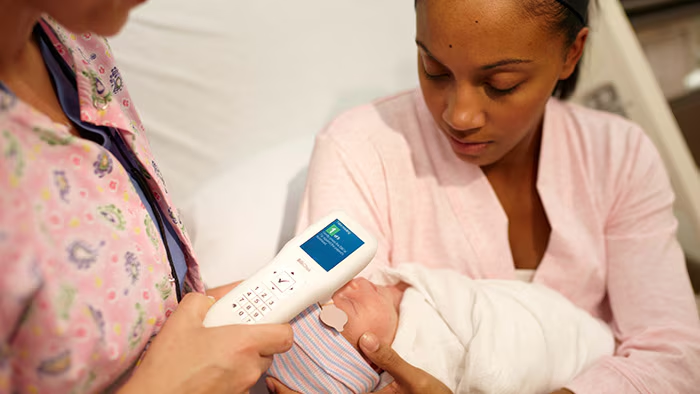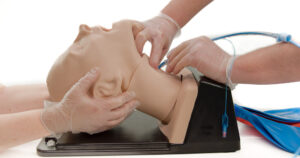TCB scans, also known as Transcutaneous Bilirubin Scans, are medical tests that help doctors check for jaundice in newborn babies. Jaundice is a condition where a baby’s skin or eyes turn yellow because there is too much of a substance called bilirubin in the blood. If not treated, high bilirubin levels can be dangerous. TCB scans help doctors find out if a baby has jaundice without using needles or drawing blood.
These scans are quick, safe, and painless. They are used in hospitals, especially in the maternity ward, and can also be done at home by trained professionals. If you’ve recently had a baby or know someone who has, understanding how TCB scans work can be helpful.
What Are TCB Scans?
TCB scans measure the amount of bilirubin in a baby’s skin. The scan is done using a small handheld device that is placed gently on the baby’s forehead or chest. The device shines a light into the skin and measures how much bilirubin is present.
The great thing about TCB scans is that they do not require taking blood from the baby. This makes the process more comfortable for the baby and less stressful for the parents. TCB scans are usually done within the first few days after a baby is born because that is when jaundice is most likely to appear.
Jaundice is common in newborns, but it usually goes away on its own. However, if bilirubin levels are too high, the baby may need treatment. TCB scans help doctors know when treatment is needed.
How Do TCB Scans Work?
TCB scans work by using a special light to detect bilirubin levels. When the light hits the baby’s skin, it measures how much of it is reflected back. Since bilirubin absorbs light in a specific way, the device can calculate how much bilirubin is in the baby’s skin based on the light that bounces back.
The scan is very fast and usually takes just a few seconds. The baby may feel the device on their skin, but it doesn’t hurt at all. This makes it a preferred method for testing newborns for jaundice. If the results of the TCB scan show that the bilirubin levels are high, the doctor might recommend more tests or treatments.
Why Are TCB Scans Important?
TCB scans are important because they help detect jaundice early. Jaundice happens when a baby’s liver is not fully developed and can’t remove bilirubin from the blood efficiently. Most of the time, jaundice is mild and goes away on its own. But if the bilirubin levels are too high, it can lead to more serious health problems, like brain damage.
By using a TCB scan, doctors can quickly find out if a baby needs treatment. The sooner jaundice is detected, the better. Treatment can include simple things like placing the baby under special lights (called phototherapy) or, in more serious cases, a blood transfusion. Early detection can prevent complications and ensure that the baby stays healthy.
How Accurate Are TCB Scans?
TCB scans are generally accurate, but they are not perfect. Sometimes, they might give a result that is a little off, especially if the baby has dark skin or if the jaundice is very severe. In such cases, the doctor may ask for a blood test to confirm the results.
Even though TCB scans are not 100% accurate, they are still a valuable tool. They allow doctors to screen babies quickly and without causing discomfort. If the scan shows high levels of bilirubin, a follow-up test is usually done to make sure the results are correct.
When Are TCB Scans Done?
TCB scans are usually done within the first 24 to 72 hours after birth. This is when newborns are most likely to show signs of jaundice. In some cases, if a baby is born early or has a higher risk of jaundice, the doctor may perform the scan sooner or more often.
If the baby is showing signs of jaundice, like yellowing of the skin or eyes, the doctor may order a TCB scan immediately. Even if the baby looks healthy, a scan may still be done as a precaution. It is always better to be safe and catch any problems early.
What Happens After a TCB Scan?
After a TCB scan, the doctor will look at the results. If the bilirubin levels are normal, no further action is needed, and the baby can go home as usual. However, if the bilirubin levels are high, the doctor may suggest treatment or recommend doing more tests, like a blood test.
In mild cases of jaundice, treatment might not be necessary, and the doctor will just keep an eye on the baby’s bilirubin levels. If treatment is needed, phototherapy is the most common method. The baby is placed under special lights that help break down the bilirubin in the skin.
Are TCB Scans Safe?
Yes, TCB scans are very safe. Since they are non-invasive, meaning no needles or blood is involved, there is no risk of infection or harm to the baby. The device used for the scan only touches the baby’s skin lightly, and the light used is completely harmless.
Parents often feel relieved knowing that TCB scans are not painful for their newborns. It’s a stress-free way to make sure the baby is healthy, and it provides peace of mind for everyone involved.
Conclusion
In conclusion, TCB scans are a simple, safe, and effective way to check newborns for jaundice. They provide a quick and painless method for measuring bilirubin levels and help doctors decide if treatment is necessary. While TCB scans may not be 100% accurate, they are an important tool in ensuring the health of newborns.



